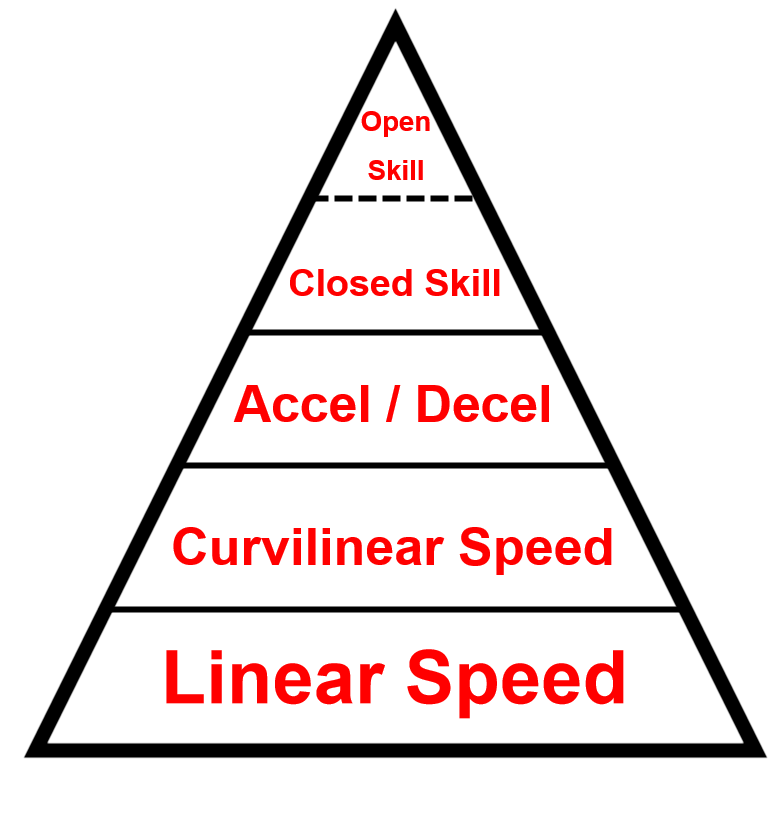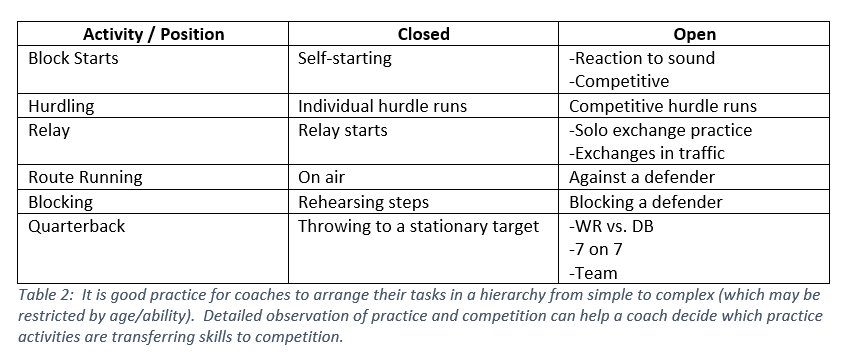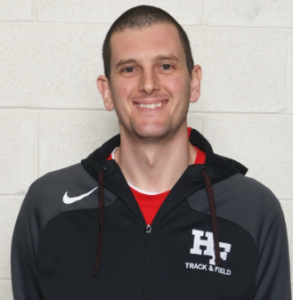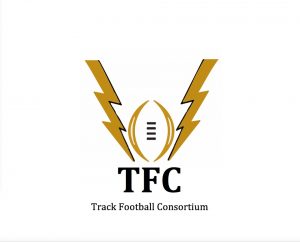
The Death of “Football Fast” and “Track Speed”
By Rob Assise, Homewood-Flossmoor High School
At TFC 4, Stuart McMillan of ALTIS expressed how he wished the phrase “drive phase” would cease to exist. He explained sprint races should be a fluid process unique to an individual. At high school track meets, abrupt changes in a runner’s body angle with the ground are visible on a regular basis, and this could be due to them feeling the need to execute their race in segmented phases (often based on prescribed cookie cutter distances).
Like Coach McMillan, I also have two phrases I wish would no longer be used in sport: “football fast” and “track speed.” When I was younger, I was guilty of using them, but as my knowledge of speed and movement have continued to evolve, I now realize they are ambiguous phrases which do not give an accurate depiction of what an athlete can do, and oftentimes short-change their abilities. My goal within this article is to provide a way we can give a more comprehensive description.
The pyramid below is an attempt to categorize different forms of biped motion. The first three levels of the pyramid are in line with their name, but in order to encompass the infinite options available, the top two levels are general.
 Figure 1: The biped pyramid is a start to giving a more accurate description of an athlete’s capabilities.
Figure 1: The biped pyramid is a start to giving a more accurate description of an athlete’s capabilities.
Linear Speed
The foundation of the pyramid is linear speed. I have written about the importance of training linear speed in the past, so I will not go into extensive detail. Although it may be viewed as the simplest form of locomotion in the pyramid, it is still extremely complex. There is no more demanding individual task for the nervous system than operating at maximum velocity. In order for an athlete to have a chance to function in an optimal manner, getting up to maximum velocity must be practiced on a regular basis. I often say that maximum velocity training is the best 2 for 1 deal in training because an athlete must work through acceleration to attain it, but with all of the benefits addressed by training at top speed, it is probably more like a 10 for 1 deal.
Curvilinear Speed
The angle the body makes with the ground differentiates linear and curvilinear running. This makes each a unique skill. In curvilinear running, applying force to the ground with a lean in the frontal plane and more activity in the transverse plane places a different demand on the musculoskeletal system. Exposing the body to these demands creates an athlete who is more resilient to injury. In response to the video below from Michael Zweifel of Building Better Athletes, legendary Coach Vern Gambetta commented, “That is hamstring (injury) prevention!” Essentially, an athlete exposed to a wide range of movement in training will be more robust.
Video 1: Track athletes must maintain speed on a bend whenever they run a curve (especially indoors). Football players are regularly faced with situations where their curvilinear ability is challenged.
Based on conversations I have had with team sport coaches, implementing curvilinear speed into training could be done more often. John Madden used to pick his defensive lineman by doing a figure 8 sprint around two goalposts (for younger readers, Madden was a football coach prior to being an announcer and the namesake of one of the greatest video game series of all-time). Madden noticed that better players had the faster times in this test.
From the track and field perspective, this type of training can be done in ways other than the obvious of running the curve on a track. Programs with an indoor track are rightfully wary of their athletes running the tight curves (especially at a high speed). Some of the drills presented in the video above provide an opportunity to expose an athlete to the demands of curve running in a manner which is less stressful to the body. It must also be noted that the athletes are having fun while completing the drills!
Another consideration for track and field comes from ITCCCA Hall of Fame Coach Ken Jakalski’s article, Another Coach’s Relay Epiphany. Jakalski states:
“As Jesse Tukuafu noted his research on curve running, ‘In order to be continuously changing direction around the curve, a runner must generate centripetal forces with the ground. This requires athletes to put some of their efforts into generating ground reaction forces that accelerate them towards the axis of rotation of the curve. As the medio-lateral (ML) ground reaction forces increase to generate centripetal forces, the vertical forces are decreased which results in a loss of running speed.’ My fastest sprinter is most likely the one whose speed through the curve decreases the least.”
This is an interesting consideration for track coaches when forming their 4×100 m relay, but an underlying take away is to practice curve running so your runners slow down less on the bend!
Acceleration / Deceleration
This movement involves an athlete accelerating and decelerating over a prescribed distance. The deceleration portion can be anywhere from a slower velocity to a complete stop. Here is an example:

What makes this portion of the pyramid unique compared to the sections above is the motion is entirely forward-facing in the sagittal plane. This skill is used most in football for skill positions running pass routes, but there are scenarios where it could be utilized by other positions.
Other than an incoming or trailing runner having to come to an abrupt stop to avoid colliding with an outgoing or leading runner, this skill is not used in track and field. Call me crazy, but I still think accelerating and decelerating has value in training. To me, it is nothing more than a way to practice acceleration and absorb force. The deceleration part is an eccentric strength exercise which requires no equipment. Cal Dietz has stated, “If you can’t absorb force, you can’t reapply it.” Force absorption-application occurs in every track event I know, and this is a simple way to enhance it. “But coach, your athletes will get shin splints!!!” As with all training, the timing and dosage must be managed appropriately to avoid adverse side effects.
Closed and Open Skills
The pyramid shows these two categories separated by a dashed line because I think it can be difficult to distinguish between open and closed skills at times. Closed skills include predefined change of direction activities (5-10-5 shuttle) or transition activities (back pedal or shuffle into a sprint). The dashed line represents the perception-action coupling (an athlete’s ability to perform a movement in response to a stimulus such as another person’s movement, light, sound, feel, an implement, etc.). This must occur in order for a skill to be considered open (and is where true agility drills reside). An article by Michael Zwiefel which discusses this in greater detail can be found here. These are some progressions from closed to open skills for track and field and football:

The Gray Area
I mentioned that a stimulus must be present in order for a skill to be considered open. In football and track races, the primary stimulus is the opponent. Field events are a different story. Most people would consider an event such as long jump to be a closed skill because there is no opponent to react to during an attempt, and there is a singular objective of jumping as far as possible. However, long jump is far from a closed skill. During the approach, an athlete is looping through the perception-action process. The next step can be altered by the interpretation of the previous one, and/or the prediction of what needs to happen in order to find success moving forward beyond the next step. All of this can be impacted by the demands of the task, the status of the organism, and impact of the environment, which is shown in the diagram below.

Figure 2: Newell’s Constraints Model has occupied a significant portion of my thoughts over the past 7 months, and I am excited to manipulate various constraints which I haven’t considered in the past to help my athletes attain their goals.
- Task
- The long jumper may be focusing on a specific technical component such as on lowering their hips on their penultimate step.
- Organism
- Do adjustments need to be made due to fatigue or arousal level?
- Environment
- Do adjustments need to be made in regards to wind, temperature, surface (dry/wet), or competition atmosphere?
The purpose of including this section was to showcase that activities which may be considered simple on the surface are much more complicated than they seem. Long jumping is not as chaotic as running with a ball and having 11 other people chasing you, but it is not just an aimless stroll through the park either!
The Need to Eliminate
Now that the different types of locomotion are in place, we can dive back into the elimination of “football fast” and “track speed.” Their use is lazy, and we as coaches can do better. What does “football fast” mean? Does the athlete have a unique ability to make people miss (excels in an open environment)? Is the athlete able to create or close space (mostly done via linear speed)? Can the athlete maintain speed on a curve? Answering these types of questions raises the quality of communication from coach to athlete, coach to coach, and coach to public.
What is meant by “track speed” is clearer, but its use varies. Half of the time I hear it in reference to a football player, it is used as a compliment. The other half it is used with disdain. For the compliment scenario, can’t we just say the athlete has great speed? I say this because there is a chance using “track speed” may be interpreted as a negative characteristic by others. And for those who use it as a knock on an athlete, is there something wrong with an athlete having great speed? Aren’t there ways to utilize “track speed” on the football field? The the last time I checked, the 40 yard dash still plays a significant role in draft position. Productive college wide receivers who may be “football fast,” but drop a 4.75 second 40 will probably find their stock plummet, and they will be wishing they had more “track speed.”
Like “football fast,” “track speed” does not give the full story of an athlete’s ability. It clearly signifies the athlete has great linear speed, but do they excel in other levels of the biped pyramid? Just saying “track speed” may exclude the athlete being able to absorb force well (accelerate / decelerate, change direction) or transition between movements well. By being detailed in the description, we avoid giving false representations. It also ensures our athlete’s strengths are utilized to the fullest. We should also do our best to get their weaknesses to a functional level. There comes a point where coaches need to decide whether an athlete’s weaknesses will or will not allow them to perform what is needed, but if we identify the weaknesses early on in a high school athlete’s career, we have four years to fill in the gaps!
A Call to Action
One of the downfalls of the Internet is we get inundated with questionable content. YouTube and social media are a blessing and a curse. Combine the curse portion with impressionable young athletes and you have a recipe for disaster. I have seen countless videos of athletes working through closed skills (“agility” ladders, change of direction drills) highlighted with the phrase “FOOTBALL FAST!” In my eyes, football coaches are diminishing the skill needed to be successful in their sport by pairing a drill which follows a predetermined path with the name of a tremendously chaotic sport. It’s like solving single step algebraic equations and calling it calculus. I’m not saying all training needs to be chaotic, just that we need to be careful with our word choice so we do not misrepresent what is being done.

Figure 3: If you are going to use social media to show what you are doing in training, be specific with what is being addressed.
The language we choose creates our message. Steve Magness states, “Language serves as a filter, as a way to judge if someone actually knows what he or she is talking about, or if they know just enough to be dangerous.” In this case, we have the ability to do better by our athletes and our profession. Let us start now.

Rob Assise is in his 15th year teaching mathematics and coaching track and field at Homewood-Flossmoor High School. He also has experience coaching football and cross country. Rob has attended all six Track-Football Consortiums and was a presenter at TFC-6. Additional writing of his can be found at Simplifaster, Just Fly Sports, and ITCCCA. He can be reached via e-mail at robertassise@gmail.com or Twitter @HFJumps.

